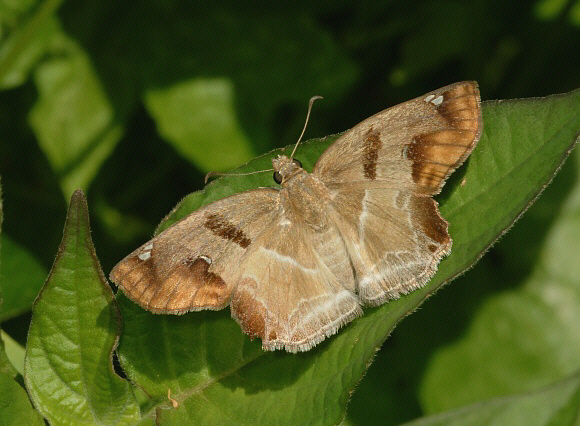
Introduction
There are only 3 species in the genus Odontoptilum, namely angulata which occurs throughout the Oriental region, pygela which is found from Thailand south through the Malay archipelago to Java, and leptogramma, which is endemic to the Philippines.
Odontoptilum are characterised by their angular wing shape ( particularly exaggerated in pygela ), and by their characteristic resting posture, as illustrated above.
This species is found in India, Sri Lanka, Nepal, Bhutan, Myanmar, Thailand, Loas, Cambodia, West Malaysia, Vietnam, China, the Philippines, Sumatra, Borneo, Sulawesi, Java and Bali.
Habitats
In Malaysia this butterfly is found in open sunny forest glades, along roadsides and riverbanks, and in other disturbed habitats at elevations between sea level and about 500 metres.
Lifecycle
The egg is very pale brownish-white, dome-shaped, and vertically ribbed. Adhering to it is a mass of fluffy pinkish hairs from the body of the butterfly, which may give it some degree of protection against the tiny wasps which often parasitise butterfly eggs. It is laid singly on the upperside of a leaf of the foodplant.
The larval foodplants include the herbaceous plants Hibiscus tiliaceus and Urena lobata; and also the trees Commersonia and Ceiba – the latter being an enormous species which can grow to 70m or more in height, and which has gigantic buttresses. All are members of the Malvaceae.
The caterpillar is white and has a very rough texture as a result of the numerous tiny tubercules and vertical wrinkles on each segment. The thorax tapers towards the head, which is dark brown and covered in pale bristles. Behind the head is a band of dark crimson.
The chrysalis is formed on the undersurface of a leaf, attached by the cremaster and a loose girdle of silk strands. It is a beautiful object, pure white in colour but marked on the back and sides with prominent rows of large black spots, and on the wing cases with fine black streaks. Either side of the thorax there is a bright orange tubercle.
Adult behaviour
The butterflies are usually seen singly, flying rapidly along sunny forest roads, or basking on low foliage. They often settle for long periods but remain very alert. If disturbed they usually zip about for a few seconds and then resettle several metres away on another leaf.
Males often settle on gravel, rocks or wooden boardwalks to imbibe moisture; and I have also seen them feeding at wet bird droppings. At these times, depending on how hot the day is, they either keep their wings outspread and slightly down-curved, or hold them erect and slightly apart.
Females are more likely to be seen nectaring at flowers.
